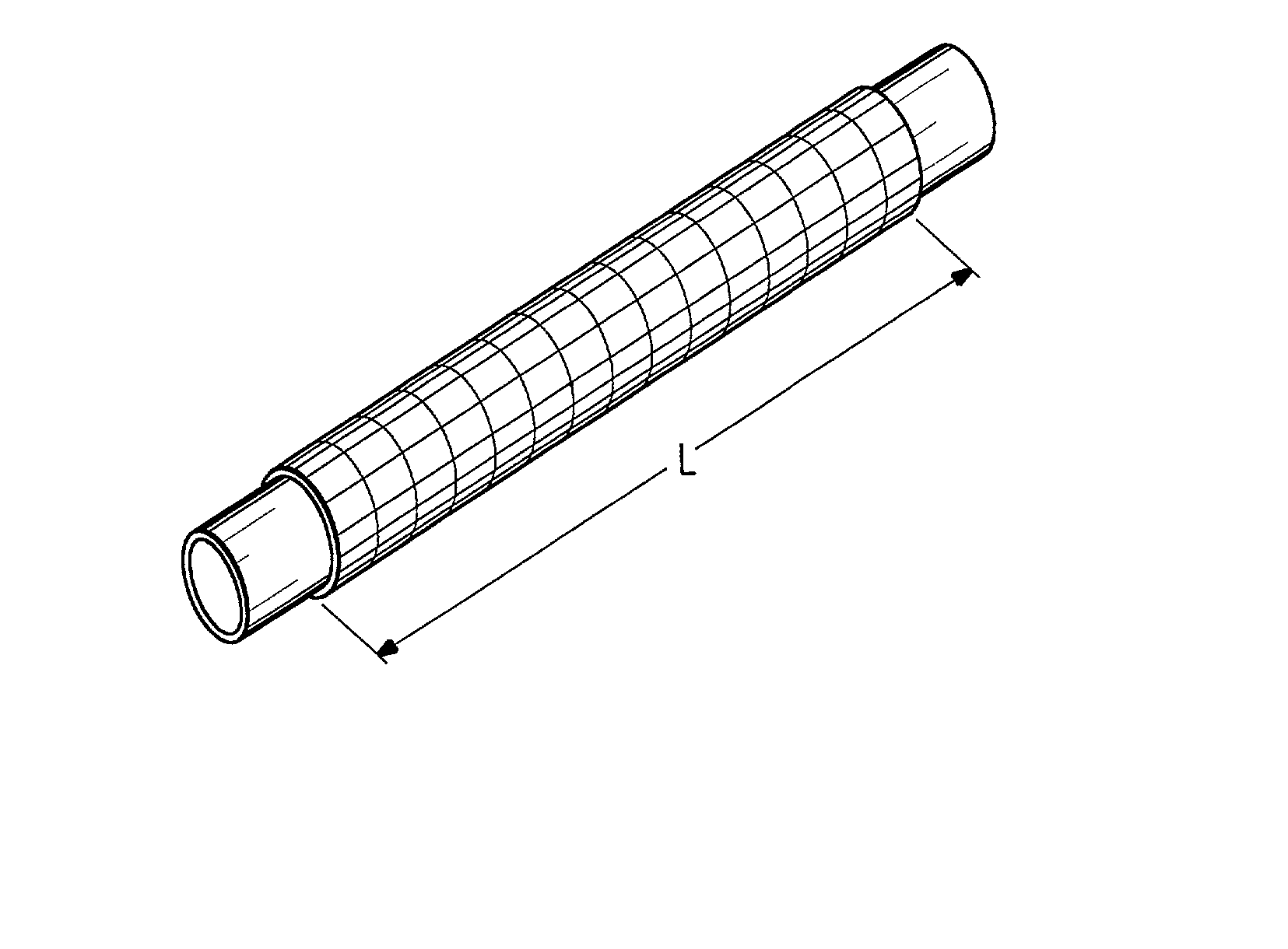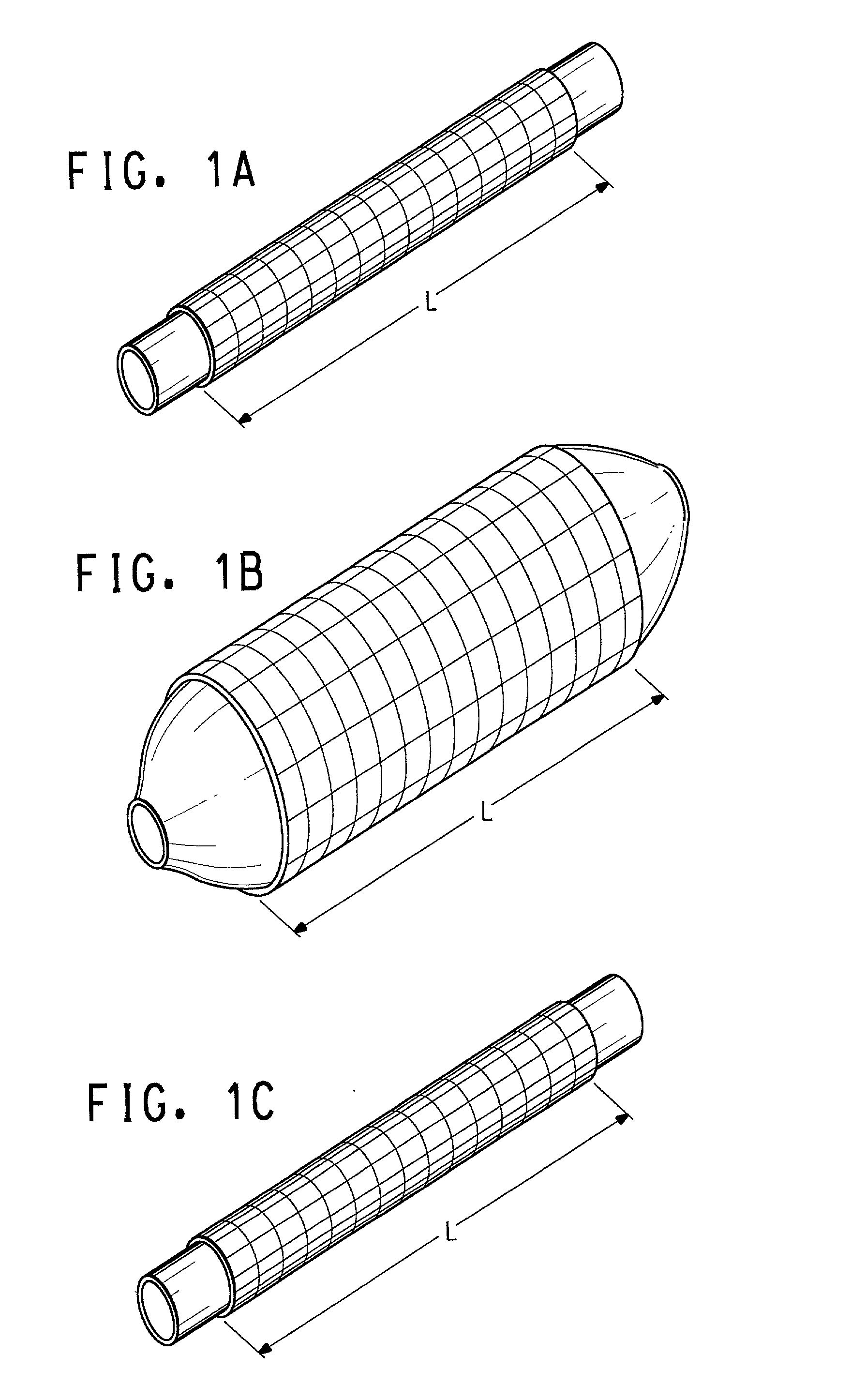Elastomeric balloon support fabric
a technology of elastomeric balloons and fabrics, applied in the direction of ornamental textile articles, catheters, braids, etc., can solve the problems of affecting the quality of balloons, so as to achieve a high degree of stretch and recovery
- Summary
- Abstract
- Description
- Claims
- Application Information
AI Technical Summary
Benefits of technology
Problems solved by technology
Method used
Image
Examples
example 1
Braided Elastomeric Fabric Sleeve
[0106] Fabric Description
[0107] The yarns in this fabric of this example are interlaced in a tubular braided geometry. Sixteen axial yarns are oriented in the longitudinal direction, and they are interlaced by two braiding yarns. The braiding yarns lie in opposing helices that are nearly perpendicular to the longitudinal axis. There are approximate 254 braiding yarns per inch of tube length. The braid diameter can be varied from about 1 to 4 mm, depending on the internal pressure, with the length of the braid remaining essentially constant.
[0108] Yarn Materials
[0109] The axial yarns are made of polyester yarns (40 denier, 27 filaments). These yarns are generally inextensible with a break elongation of 27%. The braiding yarns, on the other hand, are made of spandex fibers with a break elongation of 600%.
[0110] The spandex yarns (90 denier) have a high degree of recovery from any imposed strain. The spandex yarns permit the braided tube to change diame...
example 2
Woven Elastomeric Fabric Sleeve
[0117] Fabric Description
[0118] The yarns in this fabric are interlaced in a tubular woven geometry. Sixty ends (longitudinal yarns) are oriented in the warp direction and they are interlaced by the perpendicular filling yarn. There are approximately 90 picks (filling yarns) per inch of tube length. The tube diameter varies from about 1.3 to 4.5 mm, depending on the internal pressure, and the length of the tube remains essentially constant.
[0119] Yarn Materials
[0120] The longitudinal ends are made of polyester yarns (40 denier, 27 filaments). These yarns are generally inextensible with a break elongation of 27%. The filling yarn, on the other hand, is made of spandex fibers with a break elongation of 600%.
[0121] The spandex yarns have a high degree of recovery from any imposed strain. The spandex yarns permit the woven tube to change diameter substantially. In the collapsed state the woven diameter is 1.3 mm and this grows to approximately 4.5 mm in th...
example 3
Process for Braiding Elastomeric Fabric Sleeve Directly onto an Inflated Balloon Catheter
[0126] Fabric Description
[0127] The yarns in this fabric are interlaced in a tubular braided geometry. Sixteen axial yarns are oriented in the longitudinal direction and they are interlaced by two braiding yarns. The braiding yarns lie in opposing direction helices that are nearly perpendicular to the longitudinal axis. There are approximate 254 braiding yarns per inch of tube length. The braid diameter varies from about 1 to 4 mm, depending on the internal pressure, and the length of the braid remains essentially constant.
[0128] Yarn Materials
[0129] The axial yarns are made of polyester fibers (40 denier, 27 filaments). These yarns are generally inextensible with a break elongation of 27%. The braiding yarns, on the other hand, are made of spandex fibers with a break elongation of 600%.
[0130] The spandex yarns have a high degree of recovery from any imposed strain. The spandex yarns permit the ...
PUM
| Property | Measurement | Unit |
|---|---|---|
| Angle | aaaaa | aaaaa |
| Angle | aaaaa | aaaaa |
| Angle | aaaaa | aaaaa |
Abstract
Description
Claims
Application Information
 Login to View More
Login to View More - R&D
- Intellectual Property
- Life Sciences
- Materials
- Tech Scout
- Unparalleled Data Quality
- Higher Quality Content
- 60% Fewer Hallucinations
Browse by: Latest US Patents, China's latest patents, Technical Efficacy Thesaurus, Application Domain, Technology Topic, Popular Technical Reports.
© 2025 PatSnap. All rights reserved.Legal|Privacy policy|Modern Slavery Act Transparency Statement|Sitemap|About US| Contact US: help@patsnap.com



